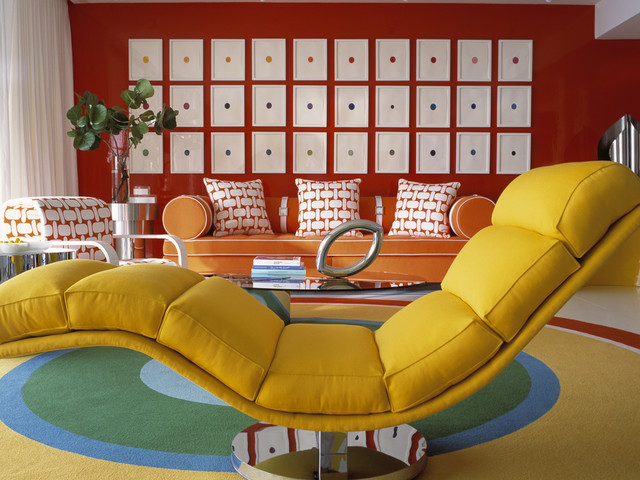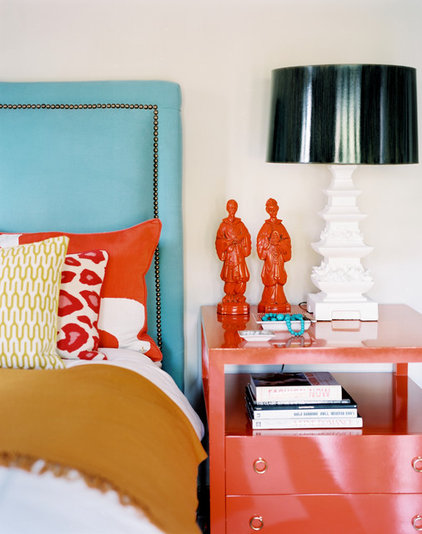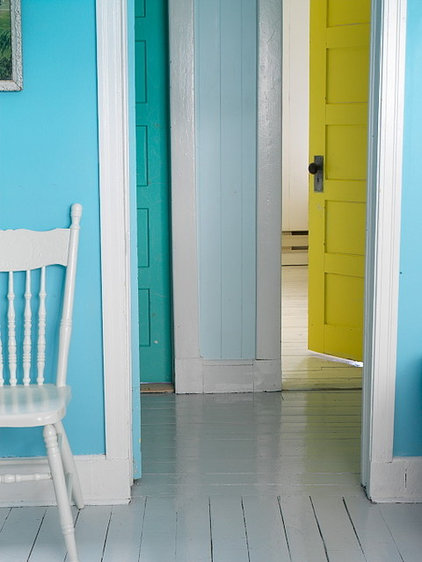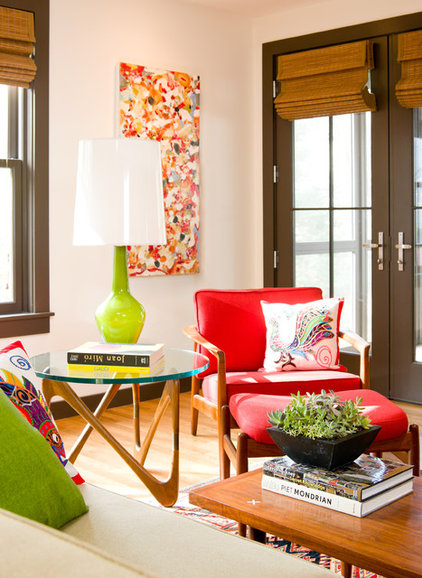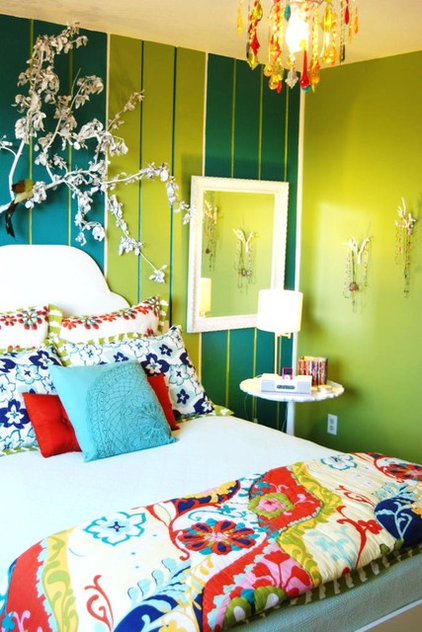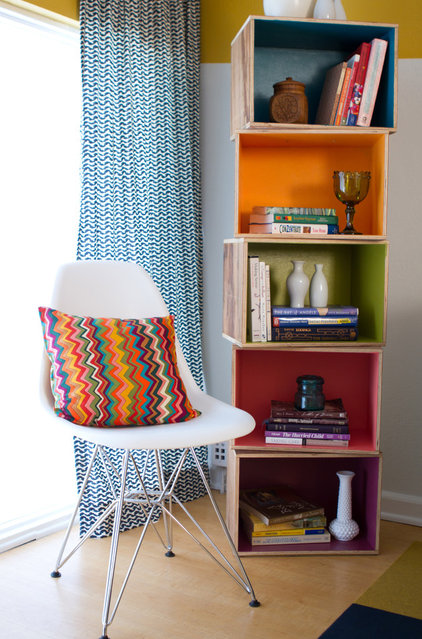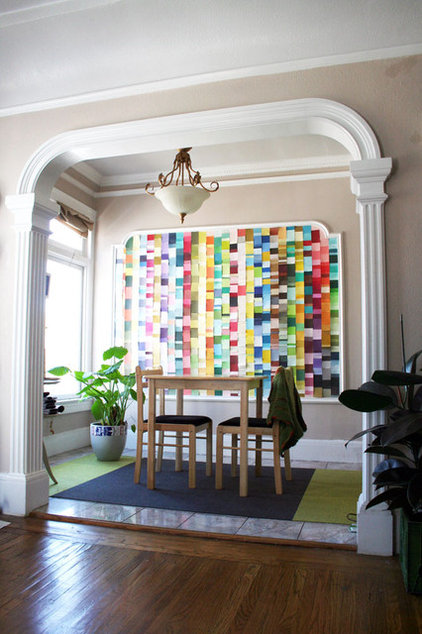So Your Style Is: Colorful
Why it works: Nothing can satisfy a color craving except color. The sheer volume of possibilities is tantalizing, and it's empowering to know that no matter what shade you pick, there's a way to pull it off. And we respond so strongly, and so personally, to colors that their effect on our mood and mind-set can be magical.
You'll love it if ... You find yourself humming "Kodachrome" in the shower. You eat the rainbow not just because it's good for you but because it looks so pretty on your plate. Your toenails are painted indigo one week and mint green the next. Your garden blooms with glowing daffodils, brilliant delphiniums and zesty poppies. You don't know why colors fall in and out of fashion — aren't they all gorgeous?
|
Style Secret: An Artful Balance
One secret to combining a lot of strong colors in a space: Pay attention to scale and proportion. In this living area, the strong zones of color help to buoy and balance one another: red wall, yellow chaise, orange sofa, blue and green rug. Take away any of these elements and the whole composition would feel off-kilter. Small visual echoes, such as the red rug border and the rainbow of framed polka dots, tie the room together. Color your world: The useful thing about this guideline is that it applies to any palette you choose. Imagine this room with a mixture of citron green, periwinkle, turquoise and Prussian blue, or with a subtler blend of cream, straw, oxblood red and blue-gray. You could even put it into practice with a stark black and white scheme, not that most color addicts could live with such restraint. |
It's color theory 101: Hues that oppose each other on the color wheel work well in combination. That means oranges complement blues, purples play nicely with yellows, and reds and greens get along. Go as bold or as pale as you like — a space done in watery blues and coral oranges can look as striking as one that's drenched in sizzling tangerine and cerulean.
Color your world: Give a room depth by layering in variations of each color. Picture a butter-colored living area with a deep eggplant sofa, punctuated with accents of taxicab yellow and pale violet. If you're intrigued by the thought of red and green but don't want a space that feels like year-round Christmas, try instead a sophisticated pairing such as olive and crimson.
Here's another lesson from the color wheel: Dress a space with analogous colors, which fall next to each other on the spectrum, rather than opposites. That might mean yellows and greens, reds and oranges, blues and purples. This space artfully marries swaths of turquoise, teal, sky and chartreuse into a cohesive whole.
Color your world: One secret to the success of the palette shown here is that the rich pigments are cut by bands of crisp white. This imbues the look with a more restful, less rambunctious feel. If you wanted to create a livelier atmosphere, however, you could skip the neutrals and just go all-out with bold hues.
If you crave a hit of color but aren't so sure about pulling out all the stops, take heart: A space can still read as colorful even when the surfaces are mostly neutral. This living room, though grounded in creams, browns and beiges, is anything but bland, thanks to the red chair and ottoman, the green accent pieces and the bright artwork.
Color your world: Because colors perform differently in relation to other hues that surround them, a neutral foundation can work to your advantage. Against the pale walls, for example, that red chair really pops. High contrast leads to drama and energy, and that's part of what a colorful room is all about.
|
Style Secret: Livable Base Hues
Under a less skillful hand, this living area could have brought on a headache. But look closer, and you'll see how masterfully it's balanced. Here's the secret: The reigning color, green, is easy on the eye (partly because we're accustomed to seeing it in nature) and easy to live with. In spite of the bold slipper chairs that appear to dominate at first glance, the magenta and persimmon hues are really just accents. Color your world: Remember the color wheel opposites we talked about a moment ago? That's what this scheme boils down to — reds and greens — and that's one reason it works. But there are enough orange and purple undertones in the mix to give the pairing an entirely new spin. |
Some people are so in love with color that they hesitate to devote themselves to a single palette. What if your fling with kelly green ends abruptly or you suddenly turn against tomato? In that case, paint is your best friend. It's easy, it's inexpensive and you can't beat it in bang-for-buck terms. Make paintable surfaces, such as walls and wooden furniture, your main sources of color in a space, and go with neutrals for items that aren't so easy to replace: sofas, tile, carpeting.
Color your world: Those with a color commitment phobia can also go with brightly patterned pieces to satisfy their changing tastes. The quilt and shams in this bedroom have enough different hues that it would be easy to pull out one, then another, then another to repeat on the walls if you were in the mood to make a change. And if the entire palette becomes old hat, small accessories are a snap to replace.
Color blocking has been around for years, in fashion as well as interior decorating. But sometimes it's hard to think beyond simply painting squares of varying shades on the walls. Remember that color blocks can take the form of any material: fabric, flooring, accessories. In this space a mustard ceiling, blue draperies and a rainbow of hues on the backs of the storage crates and the throw pillow create a blocked effect that goes far beyond the paintbrush.
Color your world: Color blocking doesn't have to be permanent. The next time you throw a dinner party, try using a different shade for each place setting and matching vessels to the tone of the foods served in them (a red transferware bowl for strawberries, perhaps, or a green majolica platter for asparagus). Or how about a modular gallery wall? Hang a series of canvases that are each painted a different solid color, then move them around or swap them out as you like.
Color and whimsy go hand in hand, so don't hesitate to have some fun. Paint each of your kitchen chairs a different shade, spatter your ceiling with wild hues, follow the lead of artist Scott Ingram and drip nail polish down a blank sheet of paper for an original abstract work. Or compile all those paint chips you've collected into a graphic composition such as the one in this dining room — so much fresher than a single painting or a mirror.
Color your world: Look for less obvious opportunities to play with color. Maybe you could arrange the books on your shelves by the shade of their spines or create a rainbow effect with your collection of Fiesta ware, glass or china. Or mass together a group of clear or plain white vases, each filled with flowers in a single, strong hue.
